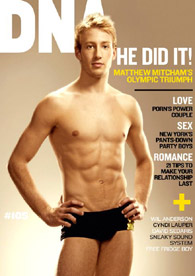Whether a pride parade is an accurate portrayal of the gay and lesbian community is a moot point. But, if the crowds, the paraders and the financial support from the NSW government are an indication, the Sydney Gay and Lesbian Mardi Gras parade is here to stay.

Above: Matthew Mitcham on the cover of Australia's DNA magazine (#105, Sept 2008 edition). Mitcham, who's the only openly gay man competing at the 2008 Beijing Olympics, won a gold in the men's 10m platform event. The 21-year-old will be the Chief of Parade at Saturday's event.
Seventy-six-year-old Steve Ostrow, project officer for the Mature Aged Gays (MAG) Project at ACON says the Mardi Gras parade is MAG's opportunity to say, 'Hey, we're still here.' "It's a display of how far we've come," says Ostrow. "So MAG will be on our double-decker bus because some of us don't walk so well anymore, and we'll be saluting the world. We'll be there to say, 'we're not extinct, we're just old.'"
Ostrow, former employer of Bette Midler and Barry Manilow at the Continental Baths in New York City, says the LGBT community is not fighting for the same things anymore and that's why the debate continues over the supposed commercialisation of the parade. "We came from an era when if you danced with a man you could be arrested. We feared enticement as well, and entrapment." Ostrow, says that inevitably, older gay men have different concerns now to what they did in the 60s, 70s and 80s. He says the main question now is, "What's going to happen to us when we're old?'"
There are others in the gay and lesbian community who don't share Ostrow's view, and argue that the parade has lost its relevance. But it's still relevant to the individual - every day people are struggling with their sexual orientation and gender identity and it is a show of support for them.
"Mardi Gras has always blended campaigning and entertainment and people have different views on how that should be weighted," says New Mardi Gras chair David Imrie. "Although New Mardi Gras creates the theme and some of the content of the parade the vast majority of entries come from community groups and individuals and so we don't really determine the political content of the parade in any one year."
But if nothing else, the parade is a barometer of the times, from the stars who head the parade, such as openly gay Australian Olympic diving gold-medalist Matthew Mitcham this year, to the politicians, the NSW police force (in uniform), the armed forces (maybe in uniform this year), and members of the Highschoolers Against Homophobia, and the Jewish and Christian communities.
And as a barometer of the times, it's obvious that we're living in a conservative age where we cannot take our rights for granted and cannot assume that they're going to continue to grow in the direction we would like them to. Globally it's looking like one step forward and two steps back.
Even so, there is a palpable disregard for the parade in some quarters, even though it is one of our most visible avenues of consciousness raising, intra and extra community. A blasť attitude perhaps due largely to ignorance on the part of the spectators, including many of the gay contingent, who aren't always aware of who is in the parade and why.
Imrie says this is why the theme Nations United was chosen for this year, namely to raise people's awareness of the issues that are effecting the LGBT community around the world, and which therefore impact on us all. Or do they?
We can champion civil unions in Ecuador on the South American float, but the two 'Uncle Sam's' on the North American float are dancing to a backdrop of California's Proposition 8.
Europe represents religious intolerance, as per the Pope's recent allusion to homosexuals being worse for the planet than climate change. Asia is in the bamboo closet, the symbolism for Africa is AIDS education or lack thereof, and Australia represents a youthful country and the inherent issues of alienation and isolation that confront gay and lesbian youth. Antarctica is the new frontier - a place where there is no legislation for or against us, or anyone else. True equality.
So the Mardi Gras, thankfully, continues to evolve and reflect the mood of the age, and also continues to entertain a whole lot of people in the process; tens of thousands of participants and hundreds of thousands of spectators who are channelling their inner exhibitionist.
The 2.4km parade will begin at 7.45pm on Saturday, Mar 7, at the corner of Elizabeth and Liverpool Streets, and continuing up Oxford Street and Flinders Street before ending at Moore Park Road intersection.

